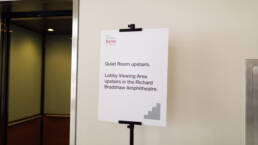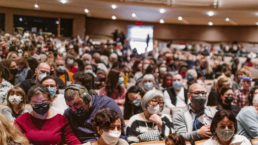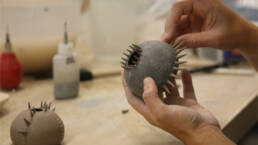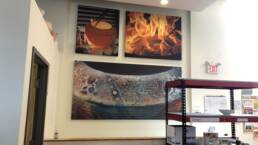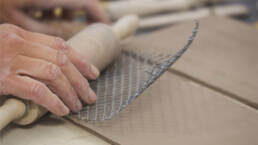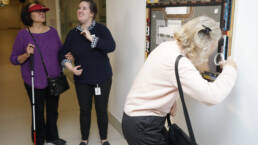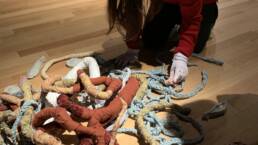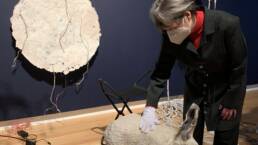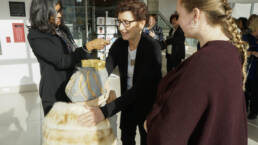Access to the Arts
This National AccessAbility Week, we celebrate programming that’s designed for inclusion
May 26, 2022 | By Lisa Bendall
More than one in five Canadians over 15 has a disability, and with our aging population this rate is expected to rise. How can arts and culture organizations welcome people with differing abilities? For National AccessAbility Week, we spoke to Rachel Marks, a disability-access consultant who works with arts organizations throughout Ontario.
“Every human has the right to benefit from the arts,” says Marks. But she acknowledges that change can be challenging. She often encourages her clients to take baby steps. “Start with the things you can do. Once you have that foundation, it becomes easier to begin offering a more robust version of access.”
Many arts and culture organizations are already on this track. In many ways, it’s a natural fit. Art, after all, is about showcasing creativity and embracing change. Here are three organizations reducing barriers to access in unique and innovative ways.
The National Ballet of Canada: Relaxed Performances
This season saw many theatres finally opening up again after a long shutdown. For the National Ballet of Canada, it was also a chance to bring its first “relaxed” performance – a show that was intentionally accessible to a wider array of audience members – to the main stage in March.
Pre-pandemic, the company had put on relaxed community-outreach performances for young students in its smaller theatre. “It definitely gave us a taste of what the community was lacking in terms of accessible performances,” says Lisa Robinson, senior manager of Education and Community Engagement.
She reached out to Marks and community groups for guidance, and the Royal New Zealand Ballet for inspiration, seeking multiple ways to make a special production of Sleeping Beauty’s Act Three a positive experience for people with different kinds of disabilities. “I tried to jump in from every avenue. I wanted to make sure all access points were there.”
House lights were kept partly on, for instance, and patrons were able to move around. A quiet room was available for anyone who needed a break. An ASL interpreter was on stage during the pre-show remarks. Audio description was available for the first time at this theater: People who couldn’t see the stage well wore headsets, listening to a narrator explain what was happening or what dancers were wearing.
Before the big day, step-by-step video guides were posted online to let theatre-goers know what to expect. Marks also provided training to theatre staff ahead of time.
The show was completely sold out. “I was emotional, seeing people walk into the theatre. It was very rewarding,” says Robinson. Many audience members said they’d never attended the ballet before, but hope to come back. They’ll get their chance, as another relaxed performance is already in the works for next season.
The London Clay Art Centre: Beauty and Function
Back when the London Clay Art Centre moved into a heritage building in the city’s old east village, accessibility – a lift to the upper floor, larger washrooms – was incorporated into the renovation plans. “Always top of mind for us, in everything we do, is imagining how can we make it better,” says executive director Darlene Pratt. “We recognize that being inclusive to all people is the right thing to do.”
When the Rick Hansen Foundation offered infrastructure improvement funds in 2017, the centre seized the opportunity to make its creative spaces even more usable. Fourteen large sound-absorbing panels – flat, fabric-covered rectangles backed with fibreglass and mounted on the walls – have helped to dampen echoes in the high-ceilinged, wide-open upstairs space where classes are held. With background noise reduced, it’s easier for people with sensory disabilities to hear.
When Pratt researched the panels, she was delighted to find out they didn’t have to be drab. “You can have them printed. I thought, that’s brilliant. We can spruce up the walls with some colour, and have the added abatement of sound.” Her group chose photos taken at the centre: close-ups of ceramic work, the dramatic flames of raku (a method of firing pottery), and children playing with clay. “They really work well, and they’re aesthetically pleasing.”
The funding also paid for a wheelchair accessible pottery wheel, automatic door openers, and equipment that can allow people to better follow along during classes – real-time speech to text captioning, and sound-transmitting technology.
“This is what you can do with some forethought and hard work,” says Pratt. “You can make these buildings not only beautiful, but functional for the widest array of people.”
Tactile and interactive tour of the Ottawa Art Gallery’s exhibitions as part of the series Mine the Gap. Photo: Ming Wu, 2018. Artwork in the photo: Eric Walker, 2017, Comment j’m’ai rendu icitte à Ottawa/How I Came to Ottawa, mixed media, Collection of the Ottawa Art Gallery: special commission for the Ottawa Art Gallery
Participant during a sound and touch based tour of Jenny McMaster’s Hare in Situ installation at the Ottawa Art Gallery, 2022. Photo: Caroline Stewart. Artwork in photo: Jenny McMaster, Hare in Situ (detail), 2021, cast abaca pulp with pigments, window screening, gypsum strips, papier-mâché, picture wire, fabric, wool roving, wound and braided cotton picture wire, raw hemp fibre, cardboard, pie tins coated with abaca pulp, contact microphone, video projection and abaca paper.
Participant during a sound and touch based tour of Jenny McMaster’s Hare in Situ installation at the Ottawa Art Gallery, 2022. Photo: Caroline Stewart. Artwork in photo: Jenny McMaster, Hare in Situ (detail), 2021, cast abaca pulp with pigments, window screening, gypsum strips, papier-mâché, picture wire, fabric, wool roving, wound and braided cotton picture wire, raw hemp fibre, cardboard, pie tins coated with abaca pulp, contact microphone, video projection and abaca paper.
Tactile and interactive tour of the Ottawa Art Gallery’s exhibitions as part of the series Mine the Gap. Photos: Ming Wu, 2018. Artwork in the photo: Stefan St-Laurent, Acadian Queen, 2018, wood and various materials, Collection of the Ottawa Art Gallery: special commission for the Ottawa Art Gallery
The Ottawa Art Gallery: Appreciating Art by Touch
The Ottawa Art Gallery thinks of accessibility in broad terms: it means providing free admission, gender-neutral washrooms, drop-in child care, and noise-cancelling headphones. “There are many different types of people whom the gallery belongs to, and we need to do our best to serve them,” says director and chief executive officer Alexandra Badzak.
Several programming initiatives are available for people with vision disabilities, including sighted-guide tours that are delivered by trained gallery staff who can describe the artwork on the walls.
Traditionally, visual art is not for touching, for fear that constant handling will eventually destroy the art. “That’s true, but there are definitely moments when we need to break through that,” Badzak says. Some exhibits have been intentionally created to be touched (disposable gloves are provided), such as a commissioned mixed-media piece about a journey across Canada, featuring raised metal shapes of train cars, buses and airplanes.
The gallery is currently partnering with Carleton University to use 3D-printed, tactile mapping, an exciting new technology that may soon enable visitors who are blind or partially sighted to feel representations of two-dimensional art pieces with their fingers.
Recently, the gallery has been working to ensure that its acquisitions, too, better represent its diverse community, seeking out more artists who themselves have disabilities. “It’s really important that organizations like ours continue to be reflective and responsive – to listen, to ask, to self-evaluate and to adapt,” says Badzak.
Marks agrees. “Hopefully we’re on a path that’s moving toward greater inclusion and acceptance,” she says, pointing out that involving more perspectives in the arts can only enrich our population as a whole. “We’re starting to understand that it betters us all to experience everyone’s stories. It broadens our viewpoint, and makes us a more accepting and open world.”
Lisa Bendall has been writing for many of Canada’s top magazines and websites for about 20 years, often focusing on health, lifestyle and disability topics. Her work has been recognized by the National Magazine Awards Foundation and the Professional Writers Association of Canada, among others.



